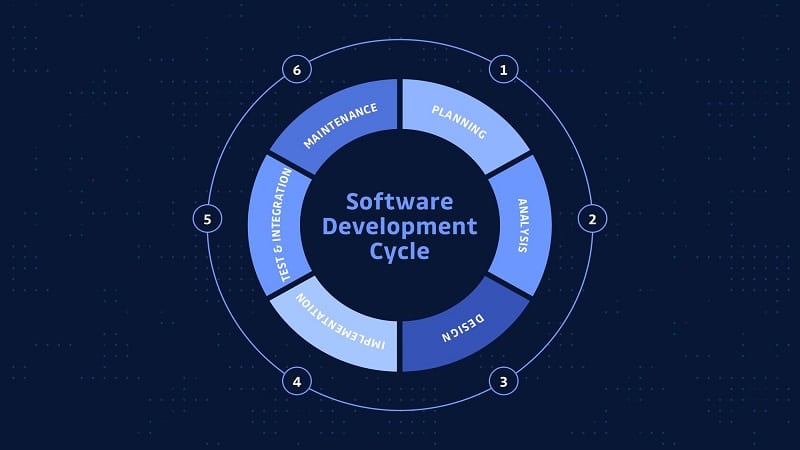
Software development life cycle (SDLC) is vital for all IT companies. Aside from streamlining daily activities, this process also ensures that everyone’s on the same page. As you can presume, the need for a well-defined methodology increases with the software’s complexity.
Among others, having a proper software development life cycle is vital when evaluating the app's effectiveness. It works on every level of development, ensuring you can minimize pre-development planning, cut costs, and improve end results.
In this article, we'll explain the 6 critical stages of the software development life cycle and why they're so important.
1. Planning

As with many other complex processes, software development starts with planning. A company needs to establish its overall goals and create an idea that would guide them throughout. According to experts from Entrance, developers must put themselves in the client's shoes to better understand their business needs and pain points.
The best way to start the process is by gathering relevant data. Developers need to have an open line of communication with their clients and also perform extensive market research. You can also check the available software solutions to see how other companies tackle a specific problem. Even if you don't use their methodology, it can serve as a good starting point.
Among others, IT companies often use SWOT analysis during this step (Strengths, Weaknesses, Opportunities, Threats). During the planning, the business needs to determine its priorities, like cost reduction or better and faster features, and focus on these software aspects. After that, they need to set minor goals for each task and start executing the development process.
2. Analysis
Analysis might be even more important than planning. During this phase, a company needs to perform sketching, create a layout, and establish MVP.
As the name indicates, sketching is a process during which you create a sketch of a new software or system. During this step, developers will create a general concept that can be tweaked along the way. Although unpolished, this initial idea will serve as a basis upon which you will add various features and functionalities.
The next step is creating the primary flow and introducing basic features. The developers need to match their flow and features based on the client's business requirements. This can be anything from having a great interface to simplifying transactions or communication. Among others, software development companies have to prepare product documents.
The analysis stage ends with MVP or minimum viable product. Developers have to establish the most basic product they can roll out on the market. Even if it has just a few features and is littered with bugs, MVP has to fulfill the requirements of early adopters.
3. Software design
Just before the design phase, a business needs a customized prototype catalog. It also needs to fully explain potential branching options so that the client can understand their complex nature and associated costs. Creating a system design is especially vital for clients as they can determine if this software is feasible for their business needs.
Based on the initial data, developers can proceed with UX design. During this step, the IT team should put itself in the users' shoes, determining potential issues that customers might have with the software. Aside from information architecture, developers also need to set up a usable prototype and set a basis for wire-framing.
The design phase ends with the user interface or UI. Like with UX design, IT professionals need to focus on customers' needs. They need to create a layout and menus that would ensure a smooth experience for anyone who would potentially use the software.
Aside from functionality, a software development company also needs to pay attention to aesthetics as something that could deter people from using the app.
4. Testing
During the testing phase, developers should provide testers with a few basic tips on how to use the program. Then, testers will check out various features to ensure they're working as intended. Most notably, they need to make sure that each feature is according to the client's requirements.
The testing phase is an extremely granular process. During this stage, testers are meant to address unit testing, performance, security, functionality, and usability. Here’s what each one of these processes entails:
- Functional testing – Checks whether the program fulfills the client's basic requirements
- Performance testing – Determines how the software would work under a heavy load. The team assesses performance in extreme situations, making sure that the product is responsive, stable, and quick
- Unit testing – During this step, the team focuses on bugs and other loopholes that would severely affect user experience
- Security testing – Assesses how the product would react to various external threats
- Usability testing – Focuses on user experience and interface and determines whether new users could quickly get ahold of the basics without previously trying software
The testing process isn't only about bugs and errors. It's a comprehensive method meant to polish various deficiencies. By the end of the testing phase, the developers should have an intuitive and well-performing product on their hands.
5. Deployment

Finally, a company will launch the finished product and make it available to all users. Alternatively, if the IT service provider made the software exclusively for the client company's needs, the client can introduce the program to their daily business workflow. During deployment, project managers have to work with clients to ensure a smooth release and maximum coverage (if necessary).
The deployment phase starts with server setup and transitions into the creation of a pipeline. Project managers should also ensure there isn't any risk from third-party filatures.
6. Maintenance
Nowadays, maintenance and frequent updates have become common for any software category. In fact, many developers continue working on programs for years and years, adding numerous features and functionalities without ever introducing new products. If you just think about it, some of the most dominant programs on the market have existed for more than a decade.
The maintenance phase gives IT companies an opportunity to earn some extra money. If they made software exclusively for the client company's needs, they could sign a maintenance agreement according to which they're meant to introduce new features over time.










